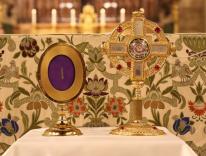Some years ago, I fell into a spirited argument about the greatest English-language novelist and novel. I declared for Charles Dickens and David Copperfield. Battling Dickens in the ring was Ms. George (Middlemarch) Eliot. Her corner man was Jim Finn, one of my esteemed predecessors at Commonweal. Meanwhile, promoters for Jane Austen, Henry James, Herman Melville, Virginia Woolf, James Joyce, and sundry others circled around, hoping to get their contender into the next bout. On and on we went in a Pickwickian spirit.
Whether or not Dickens deserves the title of greatest English-language novelist, his work constitutes our language’s greatest autobiography. Within each of his fifteen multifarious novels is an account of some part of his actual life, the one he lived and the one he was constantly turning over in his mind, writing letters about, and discussing with friends.
I was reminded of this by the trove of books occasioned by the now concluding bicentenary of Dickens’s birth (February 7, 1812). Among their topics: his novels, sketches, essays, journalism, plays, public oratory; his unrequited love followed by an unsatisfying marriage and distracted parenting of ten children; his liaison with Ellen Ternan, which caused a minor scandal; his civic agitation for prison, school, electoral, and every other kind of reform; his drawn out fights with publishers and crusade for copyright laws; his need to have income exceed expenses; his dinners, rollicking evenings with friends, and ceaseless walks around London exploring every nook and cranny. It was a life governed by endless deadlines, full of relentless activity and little sleep.
Claire Tomlin’s Charles Dickens: A Life is one of several books supplying ample evidence that much of what he wrote was snatched from his own life—the sights, sounds, and people he encountered in his perpetual walking (sometimes twenty miles a day) and journalistic assignments. The Posthumous Papers of the Pickwick Club began serialization in April 1836, shortly after Dickens had covered a by-election in Kettering for the Morning Chronicle. About that assignment, he wrote to his fiancée Catherine Hogarth, “we had a slight flare…just stopping short of murder and riot.” Consult the Pickwickian account of the electoral contest between Samuel Slumkey and Horatio Fizkin in Eatanswill (Chapter XIII)*. The names and locale are fictitious but the events stop just short of murder and riot.
Martin Chuzzlewit features the hero’s American sojourn; there he encounters the same boring, pompous, and ignorant citizenry, the same braggarts, frauds, and charlatans whom Dickens met in his 1842 tour of the United States.
Think of the boys adrift, Oliver Twist, Nicholas Nickleby, David Copperfield, Philip Pirrip (Pip), who rise from the ashes, the marshes, poverty and misfortune, overcoming daunting adversity to make their way in the world. All are variations on the traumatized young Dickens, pulled from school and sent to factory work pasting labels on jars of blacking at the age of twelve. Alas, one boy who does not survive his ordeal: little Paul Dombey, aged five; Tomlin calls him “a small Dickens.” Paul’s heartless father separates him from all he loves and sends him to Mrs. Pipchin’s boarding house. This was Dickens’s own experience at twelve. As he wrote to a friend: “It was from life, and I was there.” He was there, too, in tears, as little Paul succumbs at the hands of Dickens, the novelist.
And there’s more: Dickens’s improvident father, John Dickens, like Wilkins Micawber in David Copperfield, spent time in Marshalsea, the notorious debtors prison (and the site for the tribulations of Little Dorrit). Could Nicholas Nickleby’s distracted and somewhat addled mother have been modeled on Charles’s own? Mrs. Jellyby, the mother of many in Bleak House, could only be the image of Dickens’s wife, Catherine, who bore him more children than he wanted, though he hardly acknowledged his own role in their creation.
All writers of fiction make use of their own lives. In Dickens’s case his “fictions” were his life. True, his characters and settings are so many and various, their reality drawn with such exuberant, wild, fantastical strokes, that we might imagine they exist in a sphere far from everyday experience. Not so. As these biographies show, his life was as exuberant, wild, and fantastical as his fiction—at times stranger than his fiction. He played out his personal dramas in his head, in stories, letters, plays, staged monologues, and public readings. Today, when the boundaries between autobiography, memoir, and novel have steadily diminished, why not consider that the greatest novelist in the English language is in fact its greatest autobiographer?
+++
* From Pickwick Papers, Chapter XIII: It was late in the evening when Mr. Pickwick and his companions, assisted by Sam, dismounted from the roof of the Eatanswill Coach…. The Pickwickians had no sooner dismounted than they were surrounded by a branch mob of the honest and independent, who forthwith set up three deafening cheers.
“Slumkey for ever!” roared the honest and independent.
“Slumkey for ever!” echoed Mr. Pickwick.
“Who is Slumkey?” whispered Mr. Tupman
“I don’t know,” replied Mr. Pickwick, in the same tone. “Hush. Don’t ask any question. It’s always best on these occasions to do what the mob do.”
“But suppose there are two mobs?” suggested Mr. Snodgrass.
“Shout with the largest,” replied Mr. Pickwick.
Books discussed in this column:
Claire Tomlin, Charles Dickens: A Life (Penguin, 2011).
Robert Douglas-Fairhurst, Becoming Dickens: The Invention of a Novelist (Belknap, Harvard, 2011)
Michael Slater, Charles Dickens (Yale, 2009)
John Forster, The Life of Charles Dickens, two volumes, 1872 and 1874. Forster was Dickens’s closest friend and authorized biographer. A facsimile edition, abridged with illustrations, was published for the Dickens bicentennial (Sterling Publishing, 2011).
Related: Anthony Domestico reviews Michael Slater's Charles Dickens
Please email comments to [email protected] and join the conversation on our Facebook page.
Share
Previous Story
Wedged Apart
Next Story
The cost of health care


